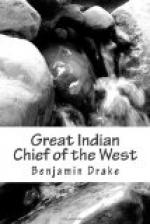“The amusement of dancing was commenced by striking up their rude instrumental and vocal music; the former consisting of a gong made of a large keg, over one of the ends of which, a skin was stretched, which was struck by a small stick, and another instrument, consisting of a stick of firm wood, notched like a saw, over the teeth of which a small stick was rubbed forcibly backward and forward. With these, rude as they were, very good time was preserved with the vocal performers, who sat around them, and by all the natives as they sat, in the inflection of their bodies, or the movements of their limbs. After the lapse of a little time, three individuals leaped up, and danced around for a few minutes; then, at a concerted signal of the master of ceremonies, the music ceased and they retired to their seats, uttering a loud noise, which, by patting the mouth rapidly with the hand, was broken into a succession of similar sounds, somewhat like the hurried barking of a dog. Several sets of dancers succeeded, each terminating as the first. In the intervals of the dances, a warrior would step forward, and strike a flag-staff they had erected, with a stick, whip, or other weapon, and recount his martial deeds. This ceremony is termed striking the post, and whatever is then said, may be relied upon as rigid truth, being delivered in the presence of many a jealous warrior and witness, who could easily detect, and would immediately disgrace the striker for exaggeration or falsehood. This is called the beggar’s dance—during which, some presents are always expected by the performers; as tobacco, whiskey, or trinkets. But on this occasion, as none of these articles were immediately offered, the amusement was not, at first, distinguished by much activity.
“The master of the ceremonies continually called aloud to them to exert themselves, but still they were somewhat dull and backward. Ietan now stepped forward, and lashed a post with his whip, declaring that he would punish those that did not dance. This threat, from one whom they had vested with authority for this occasion, had a manifest effect upon his auditors, who were presently highly wrought up, by the sight of two or three little mounds of tobacco twist, which were now laid before them, and appeared to infuse new life.
“After lashing the post, and making his threat, Ietan went on to narrate his martial exploits. He had stolen horses seven or eight times from the Kanzas; he had first struck the bodies of three of that nation slain in battle. He had stolen horses from the Ietan nation, and had struck one of their dead. He had stolen horses from the Pawnees, and struck the body of one Pawnee Loup. He had stolen horses several times from the Omawhahs, and once from the Puncas. He had struck the bodies of two Sioux. On a war party, in company with the Pawnees, he had attacked the Spaniards, and penetrated into one of their camps; the Spaniards—excepting a man and a boy—fled, himself being at a distance before his party; he was shot at and missed by the man, whom he immediately shot down and struck. ‘This, my father,’ said he, ’is the only material act of my life that I am ashamed of.’




